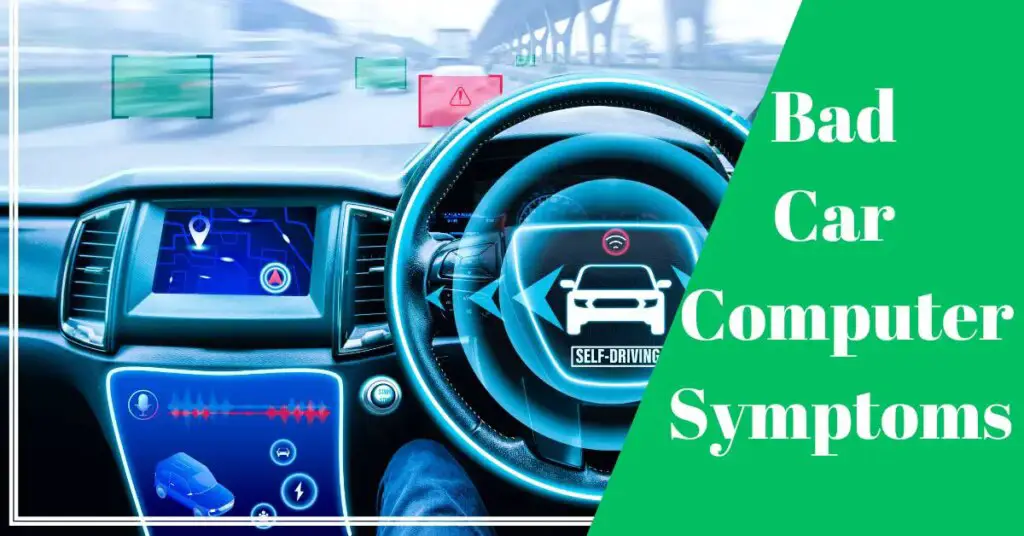Bad car computer symptoms? Ever wondered how your car’s brain works? Enter the world of car computer systems – the wizards behind your vehicle’s performance magic.
Discover how they boost fuel efficiency, tame emissions, and keep your ride smooth. In this guide, we’ll unravel their secrets, explore common issues, and arm you with expert tips for prevention and resolution.
Buckle up for a journey into the heart of automotive intelligence!
Table of Contents
What is a car computer system?
A car computer system, often referred to as an Electronic Control Unit (ECU) or Engine Control Module (ECM), is a critical component of modern vehicles that plays a pivotal role in managing and controlling various aspects of a car’s operation. These computer systems are designed to optimize performance, enhance efficiency, ensure safety, and enable the integration of advanced technologies in today’s automobiles.
Importance of Car Computers in Modern Vehicles
Performance Optimization: Car computer systems continuously monitor and adjust various parameters, such as fuel injection, ignition timing, and air-fuel mixture, to optimize engine performance. This helps improve fuel efficiency, reduce emissions, and enhance overall driving dynamics.
Emission Control: Modern vehicles are subject to stringent emission regulations. Car computers ensure that the engine operates within the prescribed emission limits by precisely controlling various emission-related components.
Safety Enhancements: Car computer systems are integral to numerous safety features, such as antilock braking systems (ABS), electronic stability control (ESC), and traction control systems. These systems help prevent skidding, improve handling, and provide a safer driving experience.
Diagnostic and Troubleshooting: Car computers constantly monitor various sensors and components within the vehicle. When an issue arises, they generate error codes and illuminate warning lights on the dashboard. Mechanics can use these codes to diagnose and address problems, making vehicle maintenance and repairs more efficient.
Advanced Driver Assistance Systems (ADAS): Many modern vehicles come equipped with ADAS, such as adaptive cruise control, lane departure warning, and automatic emergency braking. These systems rely on sophisticated car computer algorithms to interpret data from sensors and cameras and assist drivers in avoiding collisions.
Entertainment and Connectivity: Car computers also manage infotainment systems, including navigation, audio, and smartphone integration. They facilitate seamless connectivity between the vehicle and external devices, enhancing the driving experience.
Energy Management: In hybrid and electric vehicles, car computers manage the flow of energy between the internal combustion engine, electric motors, and the battery pack. This ensures efficient energy usage and maximizes the benefits of hybrid and electric propulsion systems.
Adaptive Systems: Car computers enable adaptive systems that adjust to the driver’s behavior and road conditions. For instance, adaptive headlights can automatically adjust their intensity and direction based on steering angle and vehicle speed.
In essence, car computer systems have become the brains behind modern vehicles, orchestrating a complex interplay of mechanical, electrical, and electronic components to provide a safer, more efficient, and more enjoyable driving experience.
As automotive technology continues to advance, these computer systems will play an increasingly vital role in shaping the future of transportation.
Common Functions of a Car Computer
Engine Control
One of the primary functions of a car’s computer system is to control the engine’s operation. It monitors various parameters such as engine temperature, airflow, throttle position, and oxygen levels in the exhaust gases.
Based on these inputs, the computer adjusts fuel injection timing, spark plug ignition timing, and air-fuel mixture to optimize engine performance, fuel efficiency, and emissions.
Transmission Control
The car’s computer system also manages the transmission, whether it’s an automatic or manual transmission. It controls gear shifting, torque converter lockup (in automatic transmissions), and clutch engagement (in manual transmissions).
By analyzing factors like vehicle speed, engine load, and driver inputs, the computer ensures smooth and efficient gear changes.
Emissions Control
To comply with environmental regulations and reduce harmful emissions, the car computer system monitors and adjusts various components related to emissions control.
It manages systems like the catalytic converter, exhaust gas recirculation (EGR), and oxygen sensors to maintain optimal emissions levels and minimize pollutants released into the atmosphere.
Performance Monitoring
The computer system continually monitors the vehicle’s performance through various sensors and feedback mechanisms. It keeps track of parameters such as engine speed, vehicle speed, fuel efficiency, and system temperatures.
If any abnormal conditions are detected, the computer can trigger warning lights on the dashboard, generate diagnostic trouble codes, and even implement measures to protect the engine from damage.
Fuel Management
Car computers regulate fuel delivery to the engine based on factors like engine load, throttle position, and oxygen sensor readings. This ensures efficient combustion and maximizes fuel economy.
Anti-Lock Braking System (ABS)
The car computer controls the ABS, which prevents the wheels from locking up during hard braking. It modulates brake pressure on individual wheels to maintain traction and stability, helping the driver maintain control in emergency braking situations.
Traction Control System (TCS)
TCS uses sensors to detect wheel spin during acceleration and adjusts engine power or applies braking force to specific wheels to prevent excessive wheel spin and loss of traction.
Stability Control
Stability control systems monitor the vehicle’s behavior and apply selective braking to specific wheels to help the driver maintain control during oversteer (rear-wheel skid) or understeer (front-wheel skid) situations.
Airbag Deployment
In the event of a collision, the car computer system can rapidly analyze data from crash sensors and determine when to deploy airbags for maximum occupant protection.
These functions represent only a portion of what a modern car’s computer system can manage. As automotive technology continues to advance, these computer systems become increasingly sophisticated and integral to the overall operation and safety of the vehicle.
Significance of a Well-Functioning Car Computer
A well-functioning car computer system has a significant impact on various aspects of a vehicle’s performance, efficiency, and environmental impact.
Smooth Driving Experience
A properly functioning car computer system ensures that the engine, transmission, and other critical components work together seamlessly.
This results in a smooth and responsive driving experience, with optimal power delivery, smooth gear shifts, and efficient operation. The computer system’s ability to adjust parameters in real-time enhances vehicle stability, handling, and overall driving comfort.
Fuel Efficiency
The car computer system plays a key role in optimizing fuel efficiency by carefully controlling the air-fuel mixture, ignition timing, and other engine parameters.
With precise adjustments based on real-time data from various sensors, the system ensures that the engine operates at its most efficient level, minimizing fuel consumption and saving money at the pump.
Reduced Emissions
Effective emissions control is crucial for environmental sustainability. A well-functioning car computer system helps reduce harmful pollutants by closely monitoring and managing emissions-related components.
By maintaining the optimal operating conditions for the catalytic converter, oxygen sensors, and other emission control systems, the computer system helps minimize the vehicle’s impact on air quality.
Enhanced Safety
Many advanced safety features, such as ABS, traction control, and stability control, rely on the car computer system to function properly. These systems contribute to safer driving by preventing skidding, improving traction, and helping the driver maintain control in challenging road conditions or emergency situations.
Diagnostic and Maintenance
A properly functioning car computer system aids in vehicle diagnostics and maintenance. When a malfunction occurs, the system generates diagnostic trouble codes (DTCs) that provide valuable information about the issue.
Mechanics can use these codes to quickly identify and address problems, reducing diagnostic time and minimizing downtime for repairs.
Optimized Performance
Whether you’re looking for spirited acceleration or smooth highway cruising, a well-functioning car computer system ensures that the engine delivers the desired performance characteristics.
It manages engine power, torque, and responsiveness, adapting to driving conditions and driver inputs for an optimal driving experience.
Integration of Advanced Technologies
The modern car computer system facilitates the integration of various advanced technologies, including adaptive cruise control, lane-keeping assist, and automated emergency braking.
These technologies rely on accurate data processing and control algorithms to enhance driver safety and convenience.
Longevity and Reliability
A well-maintained and functioning car computer system contributes to the overall longevity and reliability of the vehicle. Proper management of engine components and systems helps prevent excessive wear and tear, leading to a longer lifespan for the vehicle.
Identifying Bad Car Computer Symptoms
Warning Lights and Indicators
Check Engine Light
This is one of the most common warning lights that indicates a problem with the engine or emissions system. It can be triggered by various issues, ranging from minor sensor malfunctions to more serious engine problems.
ABS Light
If the Anti-Lock Braking System (ABS) light comes on, it suggests a potential issue with the ABS system. This could affect braking performance in emergency situations.
Transmission Warning Light
This light typically indicates a problem with the transmission or its associated components. It’s important to address transmission issues promptly to avoid further damage.
Unusual Engine Behavior
Rough Idling
If the engine idles roughly or erratically when the vehicle is stationary, it could be a sign of a malfunctioning sensor or incorrect fuel-air mixture.
Stalling
Frequent stalling, especially at idle or during low-speed driving, could be attributed to a faulty sensor, fuel delivery problem, or incorrect ignition timing.
Poor Acceleration
A poorly functioning car computer can lead to sluggish acceleration or a lack of power when accelerating, indicating issues with fuel management or ignition.
Transmission Issues
Gear Shifting Problems: If you experience difficulty in shifting gears or notice the transmission getting stuck in a particular gear, it might indicate a problem with the transmission control module.
Delayed or Harsh Shifts
Delayed or rough gear shifts, particularly in automatic transmissions, could be a sign of transmission control issues or improper sensor readings.
Emission Problems
Failed Emissions Test
If your vehicle fails an emissions test, it may indicate that the car computer is not effectively managing emissions-related components.
Increased Exhaust Emissions
Visible smoke from the exhaust, unusual smells, or excessive exhaust emissions can be signs of emission control problems.
Electrical Malfunctions
Electrical malfunctions in a vehicle can often be attributed to problems with the car’s electrical system, including the car computer and related components. Here are two specific symptoms related to electrical malfunctions:
Erratic Dashboard Readings
If you notice that the readings on your vehicle’s dashboard are behaving erratically or inconsistently, it could indicate an issue with the car’s electrical system.
For example, the speedometer might display incorrect speeds, fuel level readings could fluctuate rapidly, or warning lights might flicker unexpectedly. These erratic readings can stem from problems such as faulty sensors, damaged wiring, or a malfunctioning car computer.
Malfunctioning Gauges
Gauges on the dashboard, such as the speedometer, fuel gauge, temperature gauge, and tachometer, may not function properly if there is an electrical malfunction.
Gauges might get stuck, show incorrect readings, or fail to respond at all. This could be due to issues with the instrument cluster, sensor connections, or a breakdown in communication between the car computer and the gauges.
These symptoms can be frustrating and potentially impact your ability to monitor your vehicle’s performance and status. It’s important to address electrical malfunctions promptly, as they can affect various aspects of your vehicle’s operation and safety.
Causes of a Bad Car Computer
Age and Wear
Over time, the components of a car computer system can experience wear and tear, especially if the vehicle has been in use for many years or has accumulated a high mileage. This can lead to degradation of electronic components and connections, potentially causing malfunctions.
Environmental Factors
Extreme Temperatures
Both extremely high and low temperatures can impact the performance of electronic components. Prolonged exposure to extreme heat or cold can cause components to expand, contract, or even fail, leading to issues within the car computer system.
Moisture and Humidity
Moisture and humidity can infiltrate the electronic components of the car computer system, causing corrosion, short circuits, and other electrical problems. This is particularly problematic in areas with high humidity levels or during heavy rain.
Electrical Issues
Wiring Problems
Damaged or corroded wiring can disrupt the proper flow of electrical signals within the car’s system, leading to communication errors between components and affecting the car computer’s functionality.
Short Circuits
A short circuit can occur when two or more electrical connections come into direct contact, causing an unintended flow of electricity. Short circuits can damage components and disrupt the proper functioning of the car computer system.
Software Glitches
Programming Errors
The software that controls the car computer system is complex and relies on precise programming. If there are errors in the software code, it can lead to unintended behaviors, system crashes, or malfunctioning functions.
Updates and Compatibility
Software updates or changes in operating systems can sometimes lead to compatibility issues with the car computer system. Incompatibility between new software and existing hardware can result in glitches or failures.
Diagnosing and Addressing Car Computer Issues
Professional Diagnostics
OBD-II Scanner
An On-Board Diagnostics (OBD-II) scanner is a valuable tool that can retrieve diagnostic trouble codes (DTCs) stored in your car’s computer system.
Click here to see Popular OBD 2 scanner on Amazon
These codes provide insight into the specific issues affecting your vehicle. Many auto parts stores offer free code reading services, or you can invest in your own OBD-II scanner.
Dealership or Mechanic
For more complex issues or if you’re unsure about the diagnosis, consulting a professional mechanic or visiting a dealership is recommended. Mechanics have the expertise and specialized equipment to accurately diagnose and address car computer problems.
DIY Troubleshooting
Checking Fuses and Connections
Inspect the vehicle’s fuses and electrical connections to ensure they are properly connected and in good condition. A blown fuse or loose connection can cause electrical malfunctions.
Resetting the Computer
In some cases, a computer reset may resolve minor glitches. You can disconnect the vehicle’s battery for a few minutes and then reconnect it. This action will reset the car computer’s adaptive settings, but keep in mind that it might also reset other vehicle settings.
Repair or Replacement
Repairing Damaged Components
If the issue is related to a specific component, such as a damaged sensor or wiring, repairing or replacing the damaged part may resolve the problem. It’s crucial to identify and address the root cause of the issue to prevent further malfunctions.
Installing a New Car Computer
In some cases, if the car computer itself is faulty and cannot be repaired, replacing it might be necessary. This is a more involved process and typically requires professional expertise, as the new computer may need to be programmed and calibrated to work with your vehicle’s systems.
Preventing Car Computer Problems
Preventing car computer problems is essential for maintaining the overall health and performance of your vehicle.
Regular Maintenance
Cleaning and Inspecting Connectors
Periodically check and clean the electrical connectors and wiring harnesses related to the car computer system. Dust, dirt, and corrosion can affect the connections and lead to communication issues. Gently clean connectors and use a dielectric grease to protect them from moisture.
Keeping Software Up to Date
Stay up to date with software updates provided by your vehicle manufacturer. These updates can include bug fixes, enhancements, and compatibility improvements that help ensure the proper functioning of the car computer system.
Protective Measures
Using Weather-Resistant Covers
If you live in an area with extreme weather conditions, consider using weather-resistant covers to protect your vehicle from moisture, dirt, and temperature fluctuations. These covers can help shield the car’s electrical components, including the car computer, from environmental factors.
Parking in a Sheltered Area
Whenever possible, park your vehicle in a garage or sheltered area to minimize exposure to harsh weather conditions. This can help prevent moisture-related issues and temperature extremes that could impact the car computer’s performance.
Avoid DIY Modifications
While aftermarket modifications can enhance your vehicle’s performance, they can also potentially disrupt the car computer’s functioning. Incorrect installations or modifications can lead to compatibility issues and unexpected malfunctions.
Gentle Handling and Driving
Avoid Aggressive Driving
Harsh driving behaviors, such as rapid acceleration, hard braking, and aggressive cornering, can place additional stress on the car’s components, including the computer system. Driving gently and smoothly can help extend the life of your vehicle’s electronics.
Warm Up the Engine
Allow the engine to warm up before driving, especially in cold weather. This helps ensure that the engine and related systems, including the car computer, operate optimally.
Regular Inspections
Include regular check-ups with a qualified mechanic as part of your vehicle’s maintenance routine. Professional inspections can help catch potential issues early and prevent them from escalating.
Frequently Asked Questions
1: What is a car computer system?
A car computer system, also known as the Engine Control Unit (ECU) or Engine Control Module (ECM), is a complex electronic unit that controls and manages various aspects of a vehicle’s operation, including engine performance, emissions, transmission, and safety systems.
2: How does a bad car computer affect fuel efficiency?
A malfunctioning car computer can lead to incorrect fuel management, ignition timing, and other parameters. This can result in inefficient combustion, poor fuel-air mixture, and reduced fuel efficiency.
3: Can a bad car computer cause transmission problems?
Yes, a bad car computer can affect transmission performance. It may lead to erratic shifting, delayed shifts, or other issues that impact the transmission’s operation.
4: Is it safe to continue driving with a check engine light?
While a steady check engine light often indicates a less urgent issue, it’s recommended to have it checked as soon as possible. If the light is flashing, it could indicate a more severe problem that requires immediate attention.
5: How often should I have my car computer system inspected?
Including a car computer inspection as part of your regular maintenance schedule, such as during oil changes or annual check-ups, is a good practice. Consult your vehicle’s manual for manufacturer recommendations.
6: Can extreme heat damage a car’s computer?
Yes, extreme heat can potentially damage a car’s computer system. High temperatures can cause electronic components to overheat, leading to malfunctions or even permanent damage.
7: Are there any DIY methods to reset a car computer?
Disconnecting the vehicle’s battery for a few minutes is a common method to reset the car computer. However, this approach might also reset other settings and could potentially cause issues if not done correctly.
8: Can a car computer be repaired, or should it be replaced?
It depends on the extent of the damage. Minor issues may be repairable, but in some cases, a replacement may be necessary. Consulting a professional mechanic is recommended for an accurate diagnosis.
9: What steps can I take to prevent moisture-related computer issues?
Using weather-resistant covers, parking in sheltered areas, and regularly inspecting and cleaning connectors can help prevent moisture-related problems in the car computer system.
10: Are software updates for car computers necessary?
Yes, software updates are essential for maintaining the optimal performance and compatibility of your car computer system. Updates often include bug fixes, improvements, and enhancements to ensure proper functionality and compliance with standards.
In the world of modern vehicles, the car computer system stands as the digital conductor, orchestrating optimal performance, efficiency, and safety. From controlling engine dynamics to monitoring emissions and enabling advanced driver assistance systems, its significance is undeniable.
However, with age, environmental factors, and electrical glitches, problems can arise. Regular maintenance, protective measures, and proactive troubleshooting can safeguard this intricate system.
Remember, a well-functioning car computer ensures a smooth ride, efficient fuel usage, and reduced emissions.
Stay informed, stay vigilant, and embrace the technology that powers our journeys toward a safer, more connected automotive future.
Hi there! I’m Naomi O’Colman. I’ve got years of experience working at an auto repair shop here in Texas under my belt. On top of that, ever since I was a kid I’ve been passionate about the auto industry. Since I’ve joined the team at automotivegearz.com I’ve been enthusiastically sharing my passion and insights with my readers. I’m dedicated to delivering high quality content and helping you stay up to date with the latest automotive trends and products out there!







